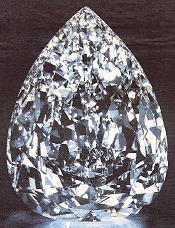 | The Millennium Star
Photo: Oliver Strange Agency |
Officially listed as the third biggest diamond ever found, the lump of crystallized carbon which became the Millennium Star was discovered in the diamond fields of the Democratic Republic of Congo - or Zaire as it was at the time. According to one story, the diamond, which weighed 777-carats (155 grammes) in its rough form, was found in 1992 near Mbuji-Mayi, a 'one-horse diamond town'.
A village chief acted on behalf community co-operative to sell it to De Beers, receiving a record price for a rough diamond. The sellers were expecting to receive cash for the stone and the De Beers representative had great difficulty in persuading them to accept a token amount of cash and have the rest paid into a bank account, which the company representative helped to organize.
According to another version of the discovery legend, two diamond 'pickers' dug a shallow hole, found the monster and took it to their local De Beers office. They also took along a negotiator, who settled for receiving all of the cash in the office as a down-payment on an eventual purchase price of $6.2million. The 'pickers' attempted to leave the area but they were not quick enough to avoid a beating from the local military for failing to give them a cut of the selling price.
Yet a third version of the legend claims that the diamond was manufactured in the former East Germany. It is know that there was a Soviet client technology centre at Potsdam, an industrial town to the south of Berlin. Such centres were established in satellite countries to avoid exposing Soviet citizens to industrial processes which involved a high risk of explosions and/or chemical contamination. Production of artificial diamonds is known to involve the use of high temperatures and pressures, and exotic, often toxic, chemicals.
The diamond is said to be the work of the late Professor Doktor Erwin Gneisz, who died in mysterious circumstances in June of 1989. It was the only product of a multi-million-dollar research programme, which had to be abandoned as the professor took the secret of his sole success to the grave.
The Democratic Republic of Congo, the more likely source of the stone, is one of the world's Big Three diamond producers, with official sales of around $400million and trading in illegally mined stones estimated at a further $500million. Mbuji-Mayi is currently occupied by soldiers from Zimbabwe as part of an unacknowledged government programme to horn in on the diamond trade to generate much needed foreign currency. Finding out what happened there a decade ago is well nigh impossible.
Whatever its origins, the stone was examined by company experts at De Beers for six months before cutting and polishing began. The experts used sophisticated scanners and computers to chart its internal structure. Specialists in New York, Antwerp and South Africa worked on the stone for three years to reduce it to the 203.04 carat Millennium Star. The finished gemstone is two inches long and the largest flawless, pear-shaped diamond in the world.
There are just 102 finished diamonds weighing more than 100 carats at the time of writing. The Millennium Star takes third place behind the First Star of Africa (530 carats), which is mounted in the sceptre used by the Queen at her coronation, and the Second Star of Africa (317 carats), which is mounted in the Imperial State Crown word by the Queen when she opens parliament.
The Millennium Collection is an attractive target for thieves as diamonds are easy to conceal, easy to transport across international frontiers and (normally) easily to dispose of. According to the experts, however, it would be extremely difficult to find someone wealthy enough to buy the largest stone if it were stolen. In fact, it could only be stolen to order as it is "unique and immediately recognizable". It is not something which could be stored for a few years and then sold as "it would be like stealing the Mona Lisa from the Louvre".
Other than holding it to ransom, the only fairly safe way to dispose of the Millennium Star would be to cut it up and create smaller stones. This process would shed a great deal of the value and an expert could still identify fragments of the Millennium Star. But if the thieves had succeeded in strolling off with the entire collection of diamonds - worth around £350million, they would have been able to sell the stones for more than enough to keep all of them in decadent luxury for the rest of their lives.
filed by Dana Howmaj [d.howmaj@md.news.uk]
 | BACK TO MD NEWS | | BACK TO MD NEWS | 
|



